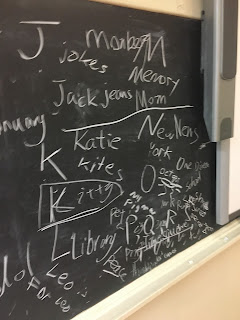 |
| A Word Wall |
At the end of the school day, most kids shuffle to their locker, collect wallets, purses, slung-over-the-shoulder book bags, and whatever else they've deigned to take home with them on a weekday afternoon. At the end of the school day, teachers make last-minute conversations, shuffle to the copier and churn out dittos (that's what we used to call those things), input grades, drink a cup of coffee and then head out the double door into oh-so-beautiful reality.
Or. Sometimes teachers bolt. Taking a breath, needing space between teacher and student, teacher and teacher, it is sometimes necessary to do the after bell plunge.
Today I bolted with a fellow teacher compatriot. We took solace on the local train back to our prospective boroughs (and burrows). I was dressed very dapper today. Normally I am presenting a six (or seven) o'clock shadow, my tie a bit untied, and the color scheme on my body jarring - to say the least. Did I tell you that yesterday I wore a shockingly yellow paisley tie on top of a red checkered shirt - complete with a professorial coat that seemed to have forgotten its trip to the laundromat? I am not sure if I should blame my slovenly father or my very exquisitely dressed mother, but I have chosen to not really take seriously the concept of "professionally dressed."
Anyway. I digress. I have thirty research papers to grade - ranging from topics such as Yankee Doodle Dandy and Bowling (the students chose their topics - those lusty scholars of learning!) - and instead of doing just that, grading, I am finding solace on my blog. And I have my wardrobe laid out for tomorrow - at least I'll look dapper again tomorrow.
Here's a shout out to all those educators out there: you do you. And do clothes make the man?






